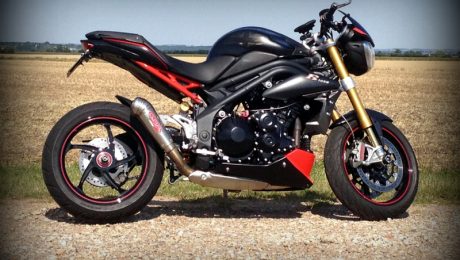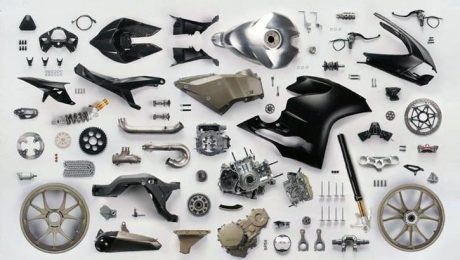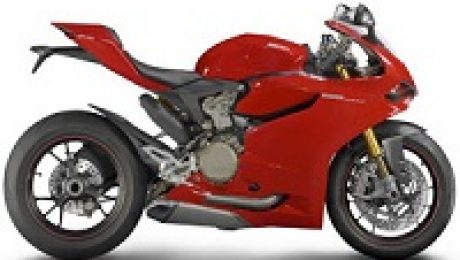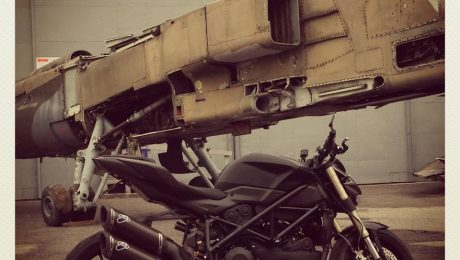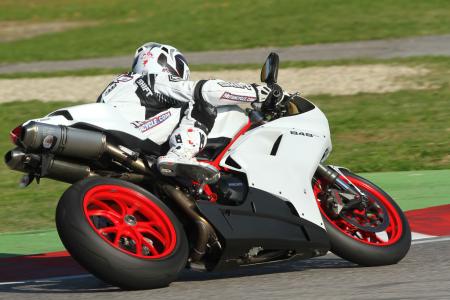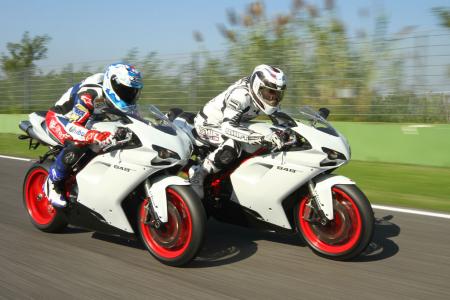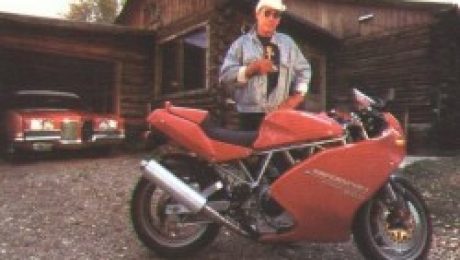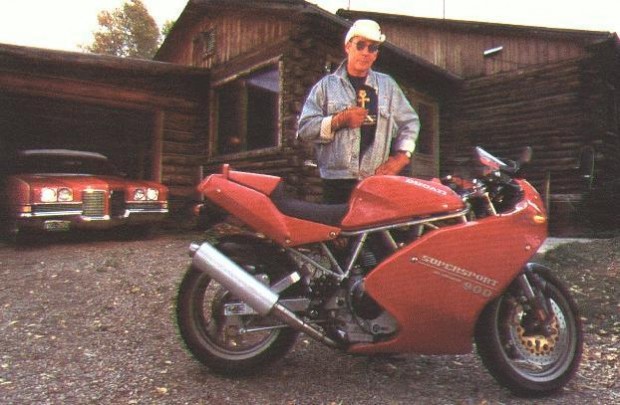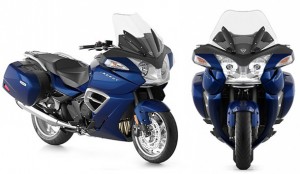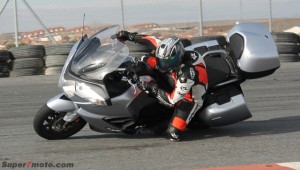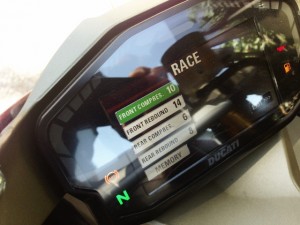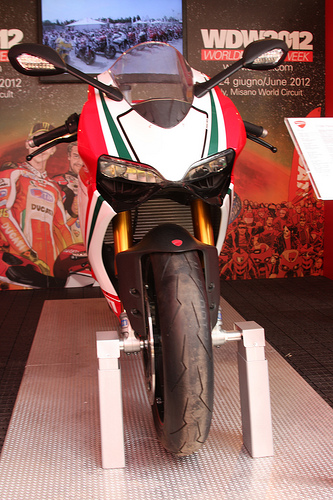Triumph Speed Triple R Review
Triumph Speed Triple R Review
| New price | £11,299 |
|---|---|
| Engine size | 1050 cc |
| Power | 133 bhp |
| Top speed | 155 mph |
| Insurance group | 14 of 17 |
The Speed Triple R has the same 133bhp, 1050cc, inline-three cylinder engine as the standard model, but uses a new-design gearbox, which will feature on the next generation of Triumph’s 1050cc triple engines. 10 of the 12 gears have been redesigned with new shafts, selector drums and selector shafts. There are now five, instead of four dogs on each new gear and the new shape and material offer a claimed increase in strength over the old design. Shaft spines are new and are formed instead of cut, reducing friction. The 6th gear ratio is now 3.4% lower.
The motor has loads of grunt, the power delivery is linear and easy to use and there’s enough oomph to easily see the naughty side of 150mph. On-track, the fuelling mid-corner at low speeds is a little snatchy.

The Speed Triple R has new Ohlins NIX fully-adjustable forks and a TTX rear shock, which gives excellent ride quality and loads of feedback and confidence in the corners. Small changes to the damping settings make a noticeable difference to the ride and handling, which you don’t get on cheaper equipment. New forged aluminium wheels are 20% lighter than cast items, reduce inertia and help the Triumph turn and stop better. New Brembo radial monobloc calipers are race-grade and offer a 5% improvement in braking, according to Triumph.
You don’t get any form electronic of rider aids, but the power delivery and chassis is so good, you don’t need them. Triumph offers a switchable ABS version for an extra £600. This R model also has a one-piece handlebar riser cap, carbon fibre radiator cowls and tank cover infil and mudguard pods, made by same company who produce carbon fibre parts for the Audi R8 and Lamborghini Gallardo Superleggera. It also has a red painted subframe and accents on the wheels, brake calipers and side panels and black-painted handlebars with an ‘R’ graphic.
Click here to view Triumph speed Triple 1050 Carbon Fibre.
The quality of the new chassis parts is unquestionable and according to reader-feedback inwww.motorcyclenews.com’s Bike Review section on the standard Speed Triple of this generation, there are no reported reliability or build quality problems.
If you want a bike that can genuinely put a smile on your face, road and track, it’s worth the extra cash over the standard model. With its designer labels, it’s now as sexy as any piece of Italian exotica and all the ‘R’ parts alone would tot-up to nearly double the £2500 premium, if you bought them separately – that’s before fitting and figuring out how to set-up the suspension.
It’s cheaper than the Ducati Streetfighter, MV Agusta Brutale 1090RR and the Aprilia Tuono V4R APRC with all the electronics, but more than the Super Duke R and the non-APRC Tuono.
But, if you’re only going to ride the Speed Triple on the road, it’s probably not worth it, like, if we’re honest with ourselves, most special-edition R and SP model super nakeds and superbikes from any manufacturer. The Triumph looks the part, handles and stops brilliantly and has better ride quality, but you only really get these benefits flat-out on-track. The rest of the time, the standard version is more than good enough.
Based on the Speed Triple launched at the beginning of 2011, this high-spec R version has Ohlins suspension, lightweight wheels, Brembo monobloc brakes, cosmetic changes, a brand new gearbox and a 2kg reduction in weight. It’s added a dynamic new dimension to the hugely popular Speed Triple, turning Triumph’s feisty street-fighter into to a hugely competent trackday tool.
Specifications
| Top speed | 155 mph |
|---|---|
| 1/4-mile acceleration | secs |
| Max power | 133 bhp |
| Max torque | 82 ft-lb |
| Weight | 221 kg |
| Seat height | 825 mm |
| Fuel capacity | 17.5 litres |
| Average fuel consumption | mpg |
| Tank range | miles |
| Annual road tax | |
| Insurance group | 14 of 17 |
| Engine size | 1050 cc |
|---|---|
| Engine specification | 12v, inline-three-cylinder |
| Frame | Twin spar tubular aluminium frame and single-sided |
| Front suspension adjustment | Fully-adjustable Ohlins 43mm upside down forks |
| Rear suspension adjustment | Single Ohlins shock, fully-adjustable |
| Front brakes | 2 x 320mm discs with four-piston Brembo radial calipers |
| Rear brake | 255mm single disc with twin-piston Nissin caliper |
| Front tyre size | 120/70 x 17 |
| Rear tyre size | 190/55 x 17 |
Source: MCN
- Published in Motorcycle Review
First Glimpse of the Ducati 1199 Panigale R Superleggera
First Glimpse of the Ducati 1199 Panigale R Superleggera
An ultra-exclusive limited edition model of the Panigale R superbike, our sources spoke of jaw-dropping figures: 220hp at the crank, and 40 lbs shed from what was already Ducati’s lightest superbike ever.
With only 500 models to be produced, this halo bike from Bologna will be available only to the upper-echelon of Ducati customers, with the Italian brand setting up an online ordering form for the chosen Ducatisti.
With copious amounts of carbon fiber, titanium, and magnesium used in its construction, we reckon the Superleggera has been a hit with everyone who has seen it, which is number that is rapidly growing.
One such lucky person was Jim Gianatsis of FastDates Calendar fame, who thankfully posted up his invite for the Ducati 1199 Panigale R Superleggera on his company’s Facebook page.
Showing a layout of the special parts that Ducati has used to make the Superleggera live up to its “superlight” name, we see that Ducati will use a magnesium piece for the frame/headstock, while a self-supporting carbon fiber seat/subframe will be used for the rear. Unsurprisingly magnesium engine pieces abound, and as we expected Ducati has chosen Marchesini forged magnesium wheels.
In equal application is the drool-worthy carbon fiber, which is naturally used for all the bodywork pieces — our favorite piece has to be what looks like a two-tone carbon/titanium exhaust can though.Choice. Other pieces include a titanium spring on the rear shock, an aluminum fuel tank, and other premium components from the likes of Öhlins and Brembo.
Using only the Superleggera’s internal name of “Project 1201″ Gianatsis’s invite goes on to mention a privatewebsite where the machine can be viewed, something we already knew existed. Going there now shows no login screen, and instead simply says “From October 10th” below a Ducati logo and the “Project 1201″ designator.
The date would seem to suggest that more could be coming this Thursday, which affirms what our spies have been saying about Ducati plan’s to leak photos of the Superleggera sometime this week. It would seem that we don’t have to wait long until more details drop about Ducati’s Superleggera. More as we get it.

Source: FastDates (Facebook)
10/10/2013 @ 12:10 AM, BY JENSEN BEELER
- Published in Motorcycle Review
Coming Soon: Ducati 1199 Panigale R Superleggera
Coming Soon: Ducati 1199 Panigale R Superleggera,
Ducati has gone to great lengths so that you won’t know this, but in about a month’s time, the Bologna Brand will debut perhaps the most ostentatious machine ever to come from the Borgo Panigale factory, the Ducati 1199 Panigale R Superleggera. An ultra-exclusive version of the Ducati 1199 Panigale R, the Superleggera edition is exactly what its Italian name suggests, a super-light version of the Panigale R.
With the Panigale R already the lightest sport bike to ever come from Ducati, the Panigale R Superleggera goes even further, employing titanium, carbon fiber, and magnesium throughout the machine to drop its curb weight by an additional 40 lbs. Ducati isn’t stopping there though.
Heavily reworking the 1,199cc Superquadro engine, the engineers at Bologna have bumped the bike’s peak horsepower figure, somehow finding a way to shoehorn 220hp into the Ducati 1199 Panigale R Superleggera.
It’s ok if you need to take a minute to readjust yourself in your chair before reading further — we’ll wait.
Other features include top of the line Öhlins suspension pieces and Brembo brakes, but the real treat is the Ducati 1199 Panigale R Superleggera’s next-generation electronics system. A direct descendent of the electronics used by Ducati Corse in WSBK and MotoGP, the Superleggera’s electronics package is highlighted with Ducati’s first wheelie control system for the street and is a direct response to Aprilia’s venerable APRC package.
At over double the price of Ducati 1199 Panigale R, the Superleggera should retail for around $65,000 when the 100 or so models that are allocated for the United States finally actually arrive.
Don’t rush out to your Ducati dealer just yet to place your deposit though, purchasing a Ducati 1199 Panigale R Superleggera is an invite-only affair for the 500 models being built — as it would seem that Bologna is taking a cue from show business’s tagline of “don’t call us, we’ll call you.”
Similar to the Ducati Desmosedici RR launch, only pre-selected Ducatisti will be given the opportunity to own one of the Panigale R Superleggera. The chosen few will receive a special access code from their local dealers, which will then allow them to order the Superleggera from Ducati.
With Ducati already contacting certain selected buyers, we imagine further details (hopefully some images) about the Ducati 1199 Panigale R Superleggera will break ahead of the machine’s EICMA debut. Stay tuned loyal Ducatisti.
Source: asphaltandrubber.com
- Published in Motorcycle Review
Ducati Streetfighter 848 Review
Ducati Streetfighter 848 Review,
In all honesty, MCN hadn’t expected great things of this bike. On one hand the new bike was at best surely only a ‘lesser’ version of the already aging Streetfighter 1098 – a bike that has slipped down the appeal ladder due to its £14,695 cost (Streetfighter S model only for 2012) and overpowering performance.

On the other, even though significantly cheaper than the 1198 version, at £10,121 it’s still much pricier than likely rivals such as Triumph’s Street Triple and MV’s Brutale 920. But then you get to ride a demonstrator and suddenly you’ll be smitten – especially if riding in the twisties, where it’s racing pedigree shines through in its chassis. Couple this with a far more user-friendly engine than the 1098 version and you get a modern, sporty, naked Ducati that works.
Take the engine; a high performing 849cc V-twin. It’s racing heritage of Testastretta engine with Desmodromic valve actuation, oval inlet manifolds and is nothing else but a smaller version of its still conquering 1198 racing weapon. With a claimed 132bhp and 69ftlb of torque, it’s a potent little beast.
That Testastretta engine is strong. Pull away with a fistful and the bike responds with little clutch action to smooth the V-twin pulses and crank clatter for clean drive. Even with the traction control turned off, the simple action of rolling open the throttle hard isn’t enough to loft the front wheel. But clutch it with revs and 848 becomes a wheelie champion from Italy. The engine feels lazy like Ducati’s of old. It doesn’t tear off in a blaze of revs but rushes forward. It’s deceptive.
The Streetfighter 848’s ace card is the perfect balance of chassis and engine. Engine braking complements the rider’s decision to slow down. Brake hard and the chassis doesn’t get fazed; no lifting rear wheel; no serious dive to cause the front end to pirouette around the headstock.
There’s so much feel from the tyres that waiting for that last yard or two to tip in for high corner speed becomes the norm. Not even a deft touch of brakes mid corner fails to upset the bike. The simple matter of raising the height of the one-piece handlebars by 20mm is in answer to Streetfighter 1098 customer feedback and it makes a big difference to rider comfort. It gives a sit-in the saddle riding position rather than being stretched on ye olde torture rack. Overall the rider feels in control from the off.
Add to this a battle proven chassis of single-sided swingarm, Brembo radial calipers, fully adjustable Marzocchi USD front forks and Sachs rear shock, and you know the Streetfighter 848 is a sporty little number, in every sense of the word, with upright handlebars. There’s also eight-way adjustable traction control (DTC) and it’s wired up ready to play with a basic data-acquisition (DDA) system to read back throttle position, rpm, speed, gear selection etc. There’s also the connections in place for a Ducati Performance accessory quick shifter to be used.
The Streetfighter 848 also comes with Pirelli Diablo Corsa 3 tyres. Varied compound tyres that are durable but sticky on the edges where it matters. What is different, though, is the fitment of 180/60 profile rear tyre instead of the tried and trusted 180/55. This is a first on any production bike.
Ducatis are exotic, high-priced performers with iffy reliability records… Sorry, but this is wrong. Ducati’s record level is actually very high and getting better all the time thanks to a big push on build quality. Ducati will, however, always be considered exotic because of its Italian breeding of design flair, beauty, sporting genes and technology.
There’s quite a good sized chunk of technology about the Streetfighter 848 and at just over £10k we are paying for it. Triumph’s Speed Triple is cheaper and with the two bikes tackling each other on the road will make for interesting reading. Ducati’s are always more expensive, it’s the nature of the beast.
Ducati Streetfighter (1098) – the original bad-boy Streetfighter. 155bhp and 85ftlb of torque make it a formidable weapon even for experienced riders.
- Published in Motorcycle Review
2013 MV Agusta Brutale 800 vs Ducati 848 Streetfigher
2013 MV Agusta Brutale 800 vs Ducati 848 Streetfigher
The Ducati 848 Streetfighter and MV Agusta Brutale 800 offer sportbike attributes and Italian cool. But which is better?
source. motorcycle.com
- Published in Motorcycle Review
MV Agusta F4RR Review
MV Agusta F4RR Review
2012 MV Agusta F4RR Review Video 201 Hp @ 13400 RPM equals pure power. Created using the most exotic materials, ultra-sophisticated suspension and short-stroke engine make the 2012 MV Agusta F4 RR the most advanced and powerful superbike in the world. The best 450 on the track—better than ever. RR, the magical acronym that immediately brings to mind the world of competition. The bike for special individuals who demand the most exhilarating riding experience. Created using the most exotic materials, ultra-sophisticated suspension and the new 1000cc short-stroke engine make the MV Agusta F4 RR the most advanced and powerful superbike in the world. When the most sophisticated chassis design is joined with the new MV short stroke engine, the result can only be an extraordinary machine. The MV Agusta F4 RR is the perfect tool for riders who demand the utmost performance. Evolved, exotic, and even further refined, the F4 RR is currently the best that technology can offer to the motorcycling world. To already refined MV Agusta F4, you add even more exotic materials, reduced weight, and, above all, a 201 hp four-cylinder engine which makes the F4 RR the most powerful superbike ever built. All “packaged” with the advanced design that makes the MV Agusta F4 RR unique and unmistakable. A project for those who demand the ultimate riding experience. Total Motorcycle is accredited …
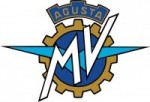
- Published in Motorcycle Review
Ducati 848 EVO 2011 Review
Ducati 848 EVO 2011 Review
Ducati’s middleweight superbike gets a significant upgrade for 2011, further separating itself from the confines of established sportbike categories.
It’s already 17 years since the first small-bore Ducati 4-valve superbike, the 748, broke cover – the same year as the iconic 916, in 1994. The 748 played a background second fiddle to the beloved 916 series until the 749 emerged in 2003. A close relation to the aesthetically challenged 999, the 749 continued to be a relatively low-cost entre into Ducati’s superbike family and competed against the Japanese 600s in supersport competition.
Then MY2008 saw a paradigm shift for the sub-liter Ducati superbikes, with the new 848 getting 15 extra horses and a weight loss of nearly 50 lbs! However, its 101cc displacement bump (to 849cc) made it ineligible for supersport competition, leaving it adrift in a class of its own.
Perhaps that’s a good thing. Instead of being considered an expensive alternative to the Japanese four-cylinders, the 848 ruled over them with not only more torque, of course, but also more horsepower. Our ’08 test bike cranked out 116 ponies at the rear wheel, which is nearly on par with what a 999 or Honda RC51 could do a few years ago when liter-sized superbikes were the hot ticket.
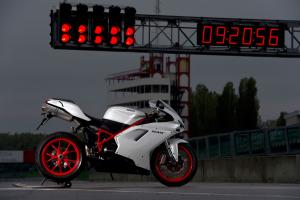
Well, Ducati has upped the ante again with the 848 EVO, bringing along extra horsepower, improved brakes and fitment of a standard steering damper – all for the same price as last year’s 848s.
To demonstrate the EVO’s newfound prowess, Ducati invited us to the historic Autodromo Enzo e Dino Ferrari in the town of Imola, Italy.
It’s within the engine that most of the EVO’s updates are found. The 848’s powerplant remains structurally unchanged, but a multitude of revisions to improve performance creates what Ducati says is “the highest power-per-liter of any twin-cylinder engine in production.”
At the intake side, the fuel-injection’s throttle body size jumps from 56mm to 60mm and feeds fuel into optimized intake ports. New cams offer increased valve lift on both the intake and exhaust sides. A revised combustion chamber and new pistons bump the compression ratio from 12.1 to a high 13.2:1. The 90-degree V-Twin’s rev ceiling has been lifted 500 revs to 11,300 rpm, and heat generated from the extra revs is dissipated by new ventilated timing belt covers.
|
There’s about 120 horses being spat out the rear wheel of the 848 EVO.
|
Ducati showed us a dyno graph comparing old and new engines, and the EVO’s has an advantage starting at 8500 rpm, with a bigger jump after 9.5K when it romps to a 6-horse surplus. Crankshaft horsepower is alleged to be 140 at 10,500 rpm. We’ll guess rear-wheel ponies will nudge past the 120-hp mark.
Positive impressions begin at start-up, as the 848’s exhaust note sounds deliciously rambunctious. They’re actually a little too boisterous for the EPA – USA bikes will be slightly quieter thanks to mufflers almost 2 inches longer.
Heading out onto the Imola racetrack, the EVO feels almost identical to the 848. Its wet clutch isn’t grabby like some of Ducati’s dry clutch packs, and low-to-midrange power easily dwarfs any sub-liter four-cylinder. Claimed dry weight remains constant at 370 lbs, so its fully fueled curb weight will come in at about 425 lbs.
|
World Superbike title contender Carlos Checa tries to keep up with Duke.
|
The EVO responds with enthusiasm when dialing on the power with an open track ahead, revving with an urgency above 9000 rpm the old bike lacked. It pulls so well up top that a rider needs to be conscious of the shift lights to engage the next gear before the rev limiter kicks in. With shifts timed accurately, the EVO is fully capable of cutting fast laps – quicker on many tracks than the 600s.
| GP Speed |
The Autodromo Enzo e Dino Ferrari nestled within the town of Imola has a rich and storied legacy, and it holds many secrets of speed until a rider can milk his best out of the Italian circuito. I learned that the blind left-hander Piratella is much faster than expected, and that the first part of the downhill Aqua Minerale requires only a short stab at the brakes. I had one other eye-opening speed lesson as I headed up Imola’s front straight for the last time of the day. With the 848 rubbing its redline in fifth gear, I grabbed a handful of brakes as the Tamburello chicane loomed closer. Then, with a shock that took my breath away, a rider flashed past on my left with at least 30 mph extra. “Oh, god,” I thought, “Someone’s lost his brakes and is going to pile in a huge way into the same area in which F1 legend Ayrton Senna lost his life.” I had one other eye-opening speed lesson as I headed up Imola’s front straight for the last time of the day. With the 848 rubbing its redline in fifth gear, I grabbed a handful of brakes as the Tamburello chicane loomed closer. Then, with a shock that took my breath away, a rider flashed past on my left with at least 30 mph extra. “Oh, god,” I thought, “Someone’s lost his brakes and is going to pile in a huge way into the same area in which F1 legend Ayrton Senna lost his life.”Then, before I could inhale, I recognized the seemingly doomed rider was none other than World Superbike race winner Carlos Checa on an 1198 – it wasn’t the first time he’d passed me. Because Checa’s one of the world’s finest riders, I knew he could handle Taburello easy enough. I relaxed momentarily. But at the same instant I was again floored by what I was seeing. Not only was the amiable Spaniard going faster and deeper into Tamburello than I’d imagined possible, he also decided to do it with flair right in front of my disbelieving eyes. My jaw dropped as Checa pitched it sideways on the brakes, leaving a black stripe of rubber from his rear tire for about 50 yards before gathering it up in time for the fast-approaching corner. I’m not worthy. –KD |
But engine tuning, like life, is a compromise. We’re stoked to have a more power at high revs, and response from the 60mm oval throttle bodies is rewardingly seamless, but the EVO seems to have lost a bit of midrange grunt compared to the Gen-1 848. Tellingly, the EVO’s torque peak is at 9750 rpm, about 1200 revs higher than we measured on our previous test bike. Strident power only arrives once past 7000 rpm, giving the EVO a respectable 4300-rpm play zone.
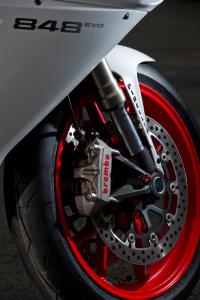 Other than the plentiful engine mods, the EVO’s most significant upgrade revealed itself when barreling downhill with a full head of steam into the Rivazza twin left-handers, one of the most intense braking zones on the Imola circuit.
Other than the plentiful engine mods, the EVO’s most significant upgrade revealed itself when barreling downhill with a full head of steam into the Rivazza twin left-handers, one of the most intense braking zones on the Imola circuit.
The 848’s new Brembo monobloc brake calipers deliver a more solid feel than the previous two-piece calipers even though they’re clamping on the same 320mm dual discs. Ducati claims 20% greater deceleration at the same lever pressure. Fluid continues to be delivered by a radial-pump master cylinder via coated, braided stainless-steel lines, delivering stellar feel. The old bike’s brakes were easily better than average, and these new binders step up the game to excellent status.
Making the 848 even more track-worthy is the addition of a steering damper sourced from the 1198. The non-adjustable unit is cross-mounted atop the upper triple clamp, and it provides some assurance the EVO wouldn’t get squirrelly even if its rider does.
Not that we had much complaint about the 848’s handling without a damper. The EVO continues the platform’s fine handling qualities, exhibiting a fairly light turn-in at low speeds, becoming more deliberate as speeds rise. It’s a solid, predictable chassis with terrific mid-corner stability.
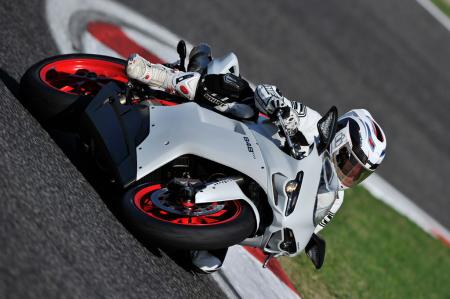 The 848 EVO loves being leaned over in the corners.
|
The final new bits on the EVO are the terrific Pirelli Supercorsa SP tires we’ve enjoyed as OE-fitment on some premium sportbikes. While the SPs are better suited for road use, we were spoiled with sticky race-compound Supercorsas (no SP, which are rated for higher speeds) developed in World Supersport competition. We ran out of nerve before they ran out of grip.
A few laps on Ducati’s new 1198SP pointed to a couple of components that would also be beneficial on its little brother. The SP’s new slipper clutch would be a nice addition for track work on the 848, as would the Ducati Quick Shifter that’s now standard on the 1198 series. The 848’s gearbox didn’t always cooperate during clutchless upshifts.
Aside from new paint color options, the 848 is stylistically unchanged in its EVO guise. For many bikes, this would be a problem. For the 848, its status-quo stance keeps it among the belles of the ball, especially in the new Arctic White Silk seen in these photos, a tasty matte-white pearl with red frame and wheels. Bella!
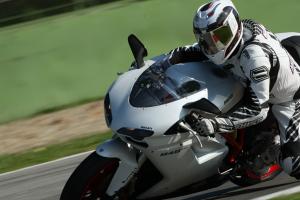
Our time aboard the EVO at Imola reaffirmed the 848’s sporting credentials, nicely upgraded for 2011 with tweaks that will help it get around a racetrack even quicker than before. It’s an upper-echelon sporting tool that can dust off a Ducati 999 if need be – or nearly anything else on a medium-speed racetrack.
Perhaps it doesn’t matter if the 848 is a bike without direct competition. It’s a strong seller for Ducati, with some 80% of buyers new to the Ducati fold, most coming from Japanese 600s. And along with Monster 696 riders, the 848 shares the distinction of having the youngest buyers among the Ducatisti.
With middleweight sportbikes from Asia pushing the $11,000 mark, it doesn’t seem like that much of a stretch to pony up another grand or so to park a Dark Stealth (matte black) 848 EVO at its $12,995 MSRP. That’s less than asked for the 749 back in 2003! The white or red EVO’s list for $1000 extra.
So, can a $13,000 Italian sportbike be a value proposition? We think so.
- source: topxmotor.com
- Published in Motorcycle Review
The Most Entertaining Ducati Review Ever
The Most Entertaining Ducati Review Ever
You know how people use Jeremy Clarkson’s reviews as examples of using 1,200 words talking about anything but the car, and tying it all together in the last possible moment? Hunter S. Thompson would give him a very good run for his money.
Re-posted below is his review of the Ducati 900SS, written for a March, 1995 issue of CycleWorld, called “Song of the Sausage Creature“. (The Sausage Creature refers to a mythical beast that chews up crashed riders, turning them into sausage.) If you know anything about Hunter S. Thompson, you’ll know he was notorious for writing about anything except what he was paid to talk about. Fear and Loathing in Las Vegas was born from an assignment on the Mint 400 Off-Road race, which he hardly covered, or even got near.
This piece is similar. Hunter goes on and on about the mental state of a cafe racers, what motorcycles mean to him, how stupid it is to ride one on the street (followed immediately by how that is the only place he rides), memories of crashing, and numerous moments of panic when he almost crashed the loaned Ducati. If you want cornering data and weight stats, go elsewhere. But if you want the most entertaining story of a motorcycle experience, woven with looks into the psyche of dare devils that, in the end, exposes why we all love speed, jump and read.
“That is the Curse of Speed which has plagued me all my life. I am a slave to it. On my tombstone they will carve, “IT NEVER GOT FAST ENOUGH FOR ME.” ” Mine too, Mr. Thompson.
There are some things nobody needs in this world, and a bright-red, hunch-back, warp-speed 900cc cafe racer is one of them – but I want one anyway, and on some days I actually believe I need one. That is why they are dangerous.
Everybody has fast motorcycles these days. Some people go 150 miles an hour on two-lane blacktop roads, but not often. There are too many oncoming trucks and too many radar cops and too many stupid animals in the way. You have to be a little crazy to ride these super-torque high-speed crotch rockets anywhere except a racetrack – and even there, they will scare the whimpering shit out of you… There is, after all, not a pig’s eye worth of difference between going head-on into a Peterbilt or sideways into the bleachers. On some days you get what you want, and on others, you get what you need.
When Cycle World called me to ask if I would road-test the new Harley Road King, I got uppity and said I’d rather have a Ducati superbike. It seemed like a chic decision at the time, and my friends on the superbike circuit got very excited. “Hot damn,” they said. “We will take it to the track and blow the bastards away.”
“Balls,” I said. “Never mind the track. The track is for punks. We are Road People. We are Cafe Racers.”
The Cafe Racer is a different breed, and we have our own situations. Pure speed in sixth gear on a 5000-foot straightaway is one thing, but pure speed in third gear on a gravel-strewn downhill ess-turn is quite another.
But we like it. A thoroughbred Cafe Racer will ride all night through a fog storm in freeway traffic to put himself into what somebody told him was the ugliest and tightest decreasing-radius turn since Genghis Khan invented the corkscrew.
Cafe Racing is mainly a matter of taste. It is an atavistic mentality, a peculiar mix of low style, high speed, pure dumbness, and overweening commitment to the Cafe Life and all its dangerous pleasures… I am a Cafe Racer myself, on some days – and it is one of my finest addictions.
I am not without scars on my brain and my body, but I can live with them. I still feel a shudder in my spine every time I see a picture of a Vincent Black Shadow, or when I walk into a public restroom and hear crippled men whispering about the terrifying Kawasaki Triple… I have visions of compound femur-fractures and large black men in white hospital suits holding me down on a gurney while a nurse called “Bess” sews the flaps of my scalp together with a stitching drill.
Ho, ho. Thank God for these flashbacks. The brain is such a wonderful instrument (until God sinks his teeth into it). Some people hear Tiny Tim singing when they go under, and some others hear the song of the Sausage Creature.
When the Ducati turned up in my driveway, nobody knew what to do with it. I was in New York, covering a polo tournament, and people had threatened my life. My lawyer said I should give myself up and enroll in the Federal Witness Protection Program. Other people said it had something to do with the polo crowd.
The motorcycle business was the last straw. It had to be the work of my enemies, or people who wanted to hurt me. It was the vilest kind of bait, and they knew I would go for it.
Of course. You want to cripple the bastard? Send him a 130-mph cafe-racer. And include some license plates, he’ll think it’s a streetbike. He’s queer for anything fast.
Which is true. I have been a connoisseur of fast motorcycles all my life. I bought a brand-new 650 BSA Lightning when it was billed as “the fastest motorcycle ever tested by Hot Rod magazine.” I have ridden a 500-pound Vincent through traffic on the Ventura Freeway with burning oil on my legs and run the Kawa 750 Triple through Beverly Hills at night with a head full of acid… I have ridden with Sonny Barger and smoked weed in biker bars with Jack Nicholson, Grace Slick, Ron Zigler and my infamous old friend, Ken Kesey, a legendary Cafe Racer.
Some people will tell you that slow is good – and it may be, on some days – but I am here to tell you that fast is better. I’ve always believed this, in spite of the trouble it’s caused me. Being shot out of a cannon will always be better than being squeezed out of a tube. That is why God made fast motorcycles, Bubba….
So when I got back from New York and found a fiery red rocket-style bike in my garage, I realized I was back in the road-testing business.
The brand-new Ducati 900 Campione del Mundo Desmodue Supersport double-barreled magnum Cafe Racer filled me with feelings of lust every time I looked at it. Others felt the same way. My garage quickly became a magnet for drooling superbike groupies. They quarreled and bitched at each other about who would be the first to help me evaluate my new toy… And I did, of course, need a certain spectrum of opinions, besides my own, to properly judge this motorcycle. The Woody Creek Perverse Environmental Testing Facility is a long way from Daytona or even top-fuel challenge-sprints on the Pacific Coast Highway, where teams of big-bore Kawasakis and Yamahas are said to race head-on against each other in death-defying games of “chicken” at 100 miles an hour….
No. Not everybody who buys a high-dollar torque-brute yearns to go out in a ball of fire on a public street in L.A. Some of us are decent people who want to stay out of the emergency room, but still blast through neo-gridlock traffic in residential districts whenever we feel like it… For that we need Fine Machinery.
Which we had – no doubt about that. The Ducati people in New Jersey had opted, for some reasons of their own, to send me the 900ss-sp for testing – rather than their 916 crazy-fast, state-of-the-art superbike track-racer. It was far too fast, they said – and prohibitively expensive – to farm out for testing to a gang of half-mad Colorado cowboys who think they’re world-class Cafe Racers.
The Ducati 900 is a finely engineered machine. My neighbors called it beautiful and admired its racing lines. The nasty little bugger looked like it was going 90 miles an hour when it was standing still in my garage.
Taking it on the road, though, was a genuinely terrifying experience. I had no sense of speed until I was going 90 and coming up fast on a bunch of pickup trucks going into a wet curve along the river. I went for both brakes, but only the front one worked, and I almost went end over end. I was out of control staring at the tailpipe of a U.S. Mail truck, still stabbing frantically at my rear brake pedal, which I just couldn’t find… I am too tall for these new-age roadracers; they are not built for any rider taller than five-nine, and the rearset brake pedal was not where I thought it would be. Mid-size Italian pimps who like to race from one cafe to another on the boulevards of Rome in a flat-line prone position might like this, but I do not.
I was hunched over the tank like a person diving into a pool that got emptied yesterday. Whacko! Bashed on the concrete bottom, flesh ripped off, a Sausage Creature with no teeth, fucked-up for the rest of its life.
We all love Torque, and some of us have taken it straight over the high side from time to time – and there is always Pain in that… But there is also Fun, the deadly element, and Fun is what you get when you screw this monster on. BOOM! Instant take-off, no screeching or squawking around like a fool with your teeth clamping down on our tongue and your mind completely empty of everything but fear.
No. This bugger digs right in and shoots you straight down the pipe, for good or ill.
On my first take-off, I hit second gear and went through the speed limit on a two-lane blacktop highway full of ranch traffic. By the time I went up to third, I was going 75 and the tach was barely above 4000 rpm….
And that’s when it got its second wind. From 4000 to 6000 in third will take you from 75 mph to 95 in two seconds – and after that, Bubba, you still have fourth, fifth, and sixth. Ho, ho.
I never got to sixth gear, and I didn’t get deep into fifth. This is a shameful admission for a full-bore Cafe Racer, but let me tell you something, old sport: This motorcycle is simply too goddamn fast to ride at speed in any kind of normal road traffic unless you’re ready to go straight down the centerline with your nuts on fire and a silent scream in your throat.
When aimed in the right direction at high speed, though, it has unnatural capabilities. This I unwittingly discovered as I made my approach to a sharp turn across some railroad tracks, saw that I was going way too fast and that my only chance was to veer right and screw it on totally, in a desperate attempt to leapfrog the curve by going airborne.
It was a bold and reckless move, but it was necessary. And it worked: I felt like Evel Knievel as I soared across the tracks with the rain in my eyes and my jaws clamped together in fear. I tried to spit down on the tracks as I passed them, but my mouth was too dry… I landed hard on the edge of the road and lost my grip for a moment as the Ducati began fishtailing crazily into oncoming traffic. For two or three seconds I came face to face with the Sausage Creature….
But somehow the brute straightened out. I passed a schoolbus on the right and got the bike under control long enough to gear down and pull off into an abandoned gravel driveway where I stopped and turned off the engine. My hands had seized up like claws and the rest of my body was numb. I felt nauseous and I cried for my mama, but nobody heard, then I went into a trance for 30 or 40 seconds until I was finally able to light a cigarette and calm down enough to ride home. I was too hysterical to shift gears, so I went the whole way in first at 40 miles an hour.
Whoops! What am I saying? Tall stories, ho, ho… We are motorcycle people; we walk tall and we laugh at whatever’s funny. We shit on the chests of the Weird….
But when we ride very fast motorcycles, we ride with immaculate sanity. We might abuse a substance here and there, but only when it’s right. The final measure of any rider’s skill is the inverse ratio of his preferred Traveling Speed to the number of bad scars on his body. It is that simple: If you ride fast and crash, you are a bad rider. And if you are a bad rider, you should not ride motorcycles.
The emergence of the superbike has heightened this equation drastically. Motorcycle technology has made such a great leap forward. Take the Ducati. You want optimum cruising speed on this bugger? Try 90mph in fifth at 5500 rpm – and just then, you see a bull moose in the middle of the road. WHACKO. Meet the Sausage Creature.
Or maybe not: The Ducati 900 is so finely engineered and balanced and torqued that you *can* do 90 mph in fifth through a 35-mph zone and get away with it. The bike is not just fast – it is *extremely* quick and responsive, and it *will* do amazing things… It is like riding a Vincent Black Shadow, which would outrun an F-86 jet fighter on the take-off runway, but at the end, the F-86 would go airborne and the Vincent would not, and there was no point in trying to turn it. WHAMO! The Sausage Creature strikes again.
There is a fundamental difference, however, between the old Vincents and the new breed of superbikes. If you rode the Black Shadow at top speed for any length of time, you would almost certainly die. That is why there are not many life members of the Vincent Black Shadow Society. The Vincent was like a bullet that went straight; the Ducati is like the magic bullet in Dallas that went sideways and hit JFK and the Governor of Texas at the same time.
It was impossible. But so was my terrifying sideways leap across the railroad tracks on the 900sp. The bike did it easily with the grace of a fleeing tomcat. The landing was so easy I remember thinking, goddamnit, if I had screwed it on a little more I could have gone a lot farther.
Maybe this is the new Cafe Racer macho. My bike is so much faster than yours that I dare you to ride it, you lame little turd. Do you have the balls to ride this BOTTOMLESS PIT OF TORQUE?
That is the attitude of the new-age superbike freak, and I am one of them. On some days they are about the most fun you can have with your clothes on. The Vincent just killed you a lot faster than a superbike will. A fool couldn’t ride the Vincent Black Shadow more than once, but a fool can ride a Ducati 900 many times, and it will always be a bloodcurdling kind of fun. That is the Curse of Speed which has plagued me all my life. I am a slave to it. On my tombstone they will carve, “IT NEVER GOT FAST ENOUGH FOR ME.” ”
Sure it wasn’t about the bike, or Ducati, or valves or new technology. Who cares. Nowadays, you can look that up. As a product review, it’s not very good, because I learned little more than that it’s fast and torquey. But if you are addicted to speed, or have dodged the Sausage Creature before, you probably connected to this piece more than you would some scribe’s take on the new R1.
Source: Latexnet.org
- Published in Motorcycle Review
The Triumph Trophy SE— Bike Review
The Triumph Trophy SE
Triumph has launched its third salvo directly at BMW. And it’s a good one. They fired the first with the 800 Tigers, the second with the 1200 Explorer, and this third with the 2013 Trophy SE.
In the case of the Trophy SE, Triumph clearly targeted the R 1200 RT. After spending time with the Trophy, I believe Triumph has not only the RT covered, but has clearly wounded the more expensive K1600 series as well. By being much better equipped than the RT and much cheaper than the K1600’s while being comparably equipped, Triumph has carved out a luxury sport-touring niche between the two that no one even knew existed (I feel uniquely qualified to say that after having previously spent extensive time riding the K1600 GTL test bike for MMM).
Our 2013 Trophy SE test bike from Belle Plaine Motorsports came very well equipped. The standard features list is impressively extensive. Electronically adjustable windshield, AM/FM satellite radio with blue tooth / aux input and weather band, mag lock powered storage console unit with usb-input, ride by wire throttle, traction control, ABS, linked brakes, 31-liter detachable saddlebags, cruise control, tire-pressure monitors, electrically adjustable windscreen, adjustable seat height, electrically adjustable headlights and shaft final drive. Whew. In addition, our test bike came with a powered 55 –liter top trunk and 2 position grip heaters. Like I said, it was well equipped! It’s icing on the cake that it all works so smashingly.
So many things work so well on this bike that it’s difficult to choose one to begin with, so lets start with what unequivocally makes this bike a Triumph – the 1215cc triple. This engine is the same one used in the Explorer, and it’s a gem!
If you have never heard a Triumph triple, you need to. It has character in spades. In Trophy guise, it has a deep V8 muscle car like sound mixed in with a bit of turbine whistle and dashed with a bit of diesel clatter over the top. It sounds distinctive and wonderful, no matter the rpm. The power characteristics mirror the sound. It has fabulous diesel like grunt off the bottom, pulls hard through the midrange like a V8 and spins freely to redline in turbine like fashion. The torque makes gear selection superfluous. This engine doesn’t wow you as much as BMW’s inline six, but it is strong, willing and full of character in its own right.
The ride by wire technology that Triumph attaches to that locomotive engine is second to none. Unlike the fluffy, laggy feeling the BMW E-gas has to it, Triumph’s version has buttery smooth tip-in, no surging or hunting at constant throttle and responds perfectly to your commands. Combine this with the fabulous engine and you have one of the best packages going. In all aspects and situations, this EFI is the model of good behavior and the standard that all others should be measured by. It also has amazing fuel mileage. I averaged from 47 – 58 mpg tanks during my travels. Combine that with the 6.9-gallon tank and you’d better make sure you visit the bathroom before you leave!
It’s a good thing that the Trophy gets such great mileage, because it’s amazingly competent and comfortable. It’s so easy to cover miles on! The wind management and protection is the best I’ve ever had. Crank the windshield all the way up and you have a serene protective cockpit. Crank it all the way down and you have good airflow at helmet and shoulder level. Drop it about 3 inches below your line of sight and you have sport touring nirvana! The ergonomics and seat are excellent and I loved the mirrors; positioned below your arms and offering an excellent vibration free view of your six.
Complementing the engine and wind management is excellent handling. Triumph is known for good handling chassis and this is another for their Trophy case. Turn in is light, communicative and trustworthy, and its bullet train stable at high speed. Helping with the handling is a top-notch electronic WP suspension (TES). Smooth and controlled at all times, it makes riding the Trophy a truly enjoyable affair. The TES has three settings you can use on the fly, “Comfort”, “Normal” and “Sport”. Comfort is a well-controlled couch. Sport is firmer in that you feel the bumps, but they are rounded off, and normal is a mix of the two. They all work great and you’ll have fun playing with them in different situations. The TES also allows custom electronic preload, “Solo”, “Solo with Luggage” and “Two-Up”. No more spinning shock collars or twisting pre load adjusters, thank you.
During one long day to northern Minnesota and back, I had ample time to play with and appreciate the electronic gadgets and luggage the Trophy has. I am happy to say that after some acclimation, I was able to easily use and enjoy everything from the satellite radio to the electronic cruise control to the numerous dash displays. I won’t get into the particulars, but I will say that having satellite radio and cruise is a luxury I could live with! The weather band was also excellent, as it would cut in with weather related alerts in my area. I spent an afternoon returning from northern Minnesota, listening to sat radio and dodging big thunderstorms. I found some interesting roads as a result and had a lot of fun!
Packing and using the luggage was simple. It’s high quality, capacious, easily removable and has a unique mounting system Triumph claims aids handling. It was a pleasure having the accessory top trunk with the extra charging port. It is absolutely worthy of a purchase with your Trophy.
I’ve ridden many different bikes in the touring and sport-touring class in my time with MMM. I can truly say that this bike has the best combination of value, content and execution of them all. It is an excellent high quality piece of hardware from one of the most storied marques in motorcycle history. I regretted having to return it and may park one in my garage permanently in the future.
In the modern touring bike field, there are massive $28,000 luxury barges, there are relatively svelte, sparsely outfitted $14,000 sport-tourers, and there are bikes that fall into a middle category – those that combine a long list of rider amenities with a highly responsive chassis design.
The 2013 Triumph Trophy SE (MSRP: $18,999) is the latter of the three. To be sure, from the very beginning, it was a sportbike designed to cover miles comfortably. After 22 years, the Trophy returns this model year with all of its past attributes refined, plus a few updates.
Powered by a responsive 1215cc three-cylinder engine producing 132hp @ 8,900 rpm and 89 lb.-ft. @ 6,450 rpm, the 2013 Trophy SE also features many of the accouterments a long-distance rider may desire, including shaft drive, hard saddlebags and a cavernous optional top case, an electronically adjustable windscreen, three-stage electronically adjustable suspension, two-step heated grips, operator and passenger outlets for heated gear, cruise control, linked ABS, switchable traction control, a tire pressure monitoring system (TPMS), Sirius-equipped audio system with Bluetooth and iPhone/iPod technology, and a full array of data accessible through the thumb-operated rider information system.
Technology
The legendary triple’s grunt of a twin and smoothness of a four translates through fly-by-wire technology, which allows that aforementioned rider information package to far exceed Honda’s offering on the Goldwing I rode last year.
In fact, the data bank is one of the key features of the Trophy SE, showing not only dual analogue gauges, fuel level, temperature, trip computers and gear position indication, but also range to empty indication, air temperature, frost warning, accessory heated seats/grips status display, cruise control and a service indicator. The really trick feature, however, is the ability to easily scroll through the menu options to manage the traction control and make suspension adjustments, choosing between Solo, Solo With Luggage, or Two-Up settings for preload and Sport, Normal and Comfort settings for damping.
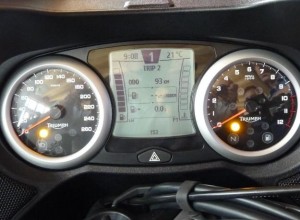
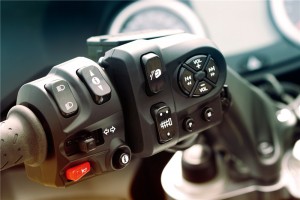
Ergonomics
The Trophy SE offered my 5’9” frame a standard upright seating position, elbows slightly bent in reaching to the bars, legs in a natural position, and posterior tucked comfortably in a generously sculpted, 31.1-inch-high saddle that didn’t prove to cause any pressure points during a 200-mile jaunt.
Adjustable levers and foot controls were standard fair, with reach and pull of the levers proving easy and plenty of foot room despite the 1.2L lump pulsing between your legs. Speaking of foot position – a rainy commute showed Triumph
intelligently designed foot placement to keep your pants and feet dry. Go figure, the UK isn’t exactly known for its warm and dry conditions.
But it’s the windshield that proves to be the crown jewel of the Trophy’s thoughtfully planned rider space. Not only does it electronically adjust six inches to suit your pleasure, but it also actually remembers its last position. So, when you start the bike, you don’t have to waste time readjusting it.
Performance
Starting the Trophy SE delivers a welcome message and light show from the dash and a boom from the three-into-one side mounted stainless steel silencer. At idle the bike sounds robust but docile enough for even the most conservative of neighborhoods. Just off idle and the sound becomes more like that of a muscle car than a Gentleman’s Tourer.
Slipping into gear delivered a solid click and the bike proved easy to use at urban speeds, with the weight diminishing and the engine and transmission working in concert to deliver a smooth, almost maxi scooter-like ride. Keep it in second gear while downtown or during rush hour congestion and you may forget the bike has a clutch.
At 72 mph in sixth gear the engine turns at a whisper quiet 3,800 rpm. Twist your wrist and the big lump moves away with a purpose; downshift one notch before twisting and the engine jumps up to 4,400 rpm. Now you’re in the sweet spot and the entire 662-lb. package leaps to attention and rockets you down the road with turbine-like force and the bark of a beautiful Triple Symphony. Forget about torque pull from the shaft drive, this baby feels drag strip precise as triple digits show up in two blinks of an eye.
Bringing the big Trophy SE down from speed was drama free, even in panic situations, with the twin 320mm floating discs bitten by Nissin four-piston calipers in front and single 282mm disc with twin-piston caliper in the rear. There wasn’t a lot of diving to upset chassis performance and the ABS did not noticeably impede my inputs but in fact stoked my trustworthiness in the bike.
Don’t be afraid to dive into the corners, either. The Trophy’s sportbike-derived design, electronically adjustable WP suspension, and 120/70 ZR17 front and 190/55 ZR17 rear tires keep the bike line-on through the curves while its aero package alludes to its excellent road manners; even on a day with 15mph crosswinds and the screen at full attention, there was very little to no buffeting on the bike while sweeping around south central Minnesota corn and soybean fields. Even Triumph’s “dynamic luggage system” was designed for speed – allowing a small amount of independent movement from wind buffeting, which actually increases stability.
After having switched between multiple electronic suspension combinations, I can attest that the system works – firming up the ride for solo maneuvers, providing an appropriate amount of feedback under load, and offering plushness for your significant other enjoying the experience on the back.
What didn’t I like on Trophy SE? The most glaring of problems I encountered during my time with the bike was the constant need to keep tabs on the information shared via the digital dash. In fact, I didn’t need to pay attention to any of that and so the issue really is a personal one.
Ultimately, riding this bike constantly reminded me how the Brits appear to have the Germans in their crosshairs. If this is Triumph’s answer to BMW’s ever-popular R 1200 RT ($17,350) it could wing to wing … er, wheel to wheel … take on the Roundel’s longtime superiority on the Interstate, Autobahn, Autostrada or Dual Carriage Way.
- Published in Motorcycle Review, Uncategorized
Ducati 1199 Panigale S v R
Ducati 1199 Panigale S v R
We’ve spent the last two weeks living with the fastest motorcycle in the world, the Ducati 1199 Panigale R, also riding it alongside the less exotic Ducati 1199 Panigale S. How do the two stack up in the real world?
We just went to ProItalia.com and added up the price of that exhaust ($3,568.90), DDA kit ($600), seat ($264.10), sprockets ($389.75) and screen ($151.90) and got a total of $4,974.65. That obviously doesn’t include the adjustable swingarm pivot, engine parts or aluminum tank. Considering the R carries only a $7,000 premium over the $22,995 S, that actually makes it something of a bargain.
The other big differences come from the screen, which does a much better job of directing wind blast over your shoulders, even at legal highway speeds and, surprisingly, that suede seat. Where my Roadcrafter was unable to grip the slippery stock seat at all, the suede helped me stay in place during braking and acceleration and helped me relax more while hanging off around corners.
The full-color, TFT screen is bright and conveys information clearly and immediately.
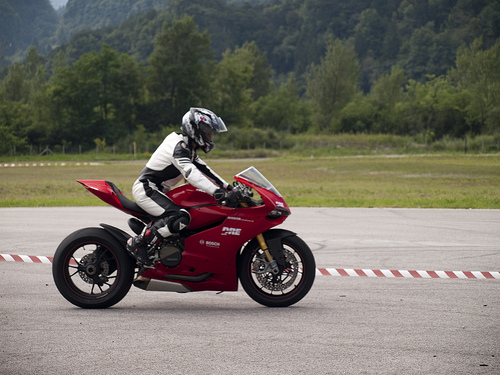
The Verdict
That the Ducati 1199 Panigale R remains useable on the street is quite the accomplishment, given its absolute-fastest race track performance. Still, you can go just as fast on the road with the S on a bike that looks just a nice to 99.9 percent of people. Maybe because we’re fresh off hitting 202mph on one down at COTA, but we didn’t mind posing on this R one bit. “I’ve got the fastest bike in the world, in my garage,” just has a nice ring to it.
RideApart Rating
Ducati 1199 Panigale R: 10/10
Ducati 1199 Panigale S: 9/10
- Published in Motorcycle Review


